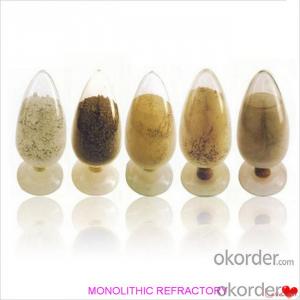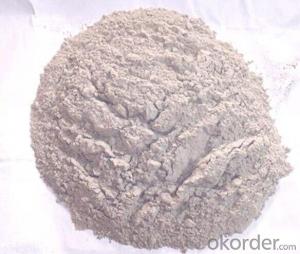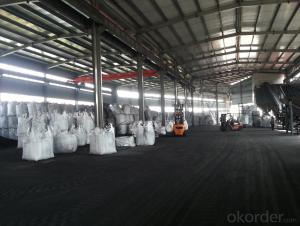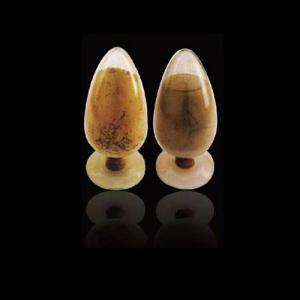Alumina-Spinel Castable for Ladle
- Loading Port:
- China Main Port
- Payment Terms:
- TT or L/C
- Min Order Qty:
- 2 MT m.t.
- Supply Capability:
- 5000 Tons Per Month m.t./month
OKorder Service Pledge
OKorder Financial Service
You Might Also Like
General Information of Alumina-Spinel Castable for Ladle
ALRE alumina-spinel castable for ladle made strictly as per international standards, is known for its long operating life, excellent corrosion resistance and high refractoriness.
Technical data of Alumina-Spinel Castable for Ladle
Item | Alumina spinel castable | ||||
Al2O3 | % | ≥ | 72 | ||
MgO | % | ≥ | 10 | ||
CaO | % | — | |||
SiO2 | % | ≤ | 9 | ||
SiO2+ Fe2O3+ Al2O3 | % | ≤ | |||
Bulk density ≥ | g/cm3 | — | |||
C.C.S. (MPa) ≥ | 110℃×24hrs | 90 | |||
1500℃×3hrs | 100 | ||||
M.O.R.(MPa) ≥ | 110℃×24hrs | 11.5 | |||
1500℃×3hrs | 11.5 | ||||
Refractoriness (℃) ≥ | — | ||||
Grain size (mm) ≤ | — | ||||
Permanent linear change | 1500℃×2hrs | -0.2~0.35 | |||
1500℃×3hrs | — | ||||
Life time (hr) | — | ||||
Production line and Packing of Alumina-Spinel Castable for Ladle
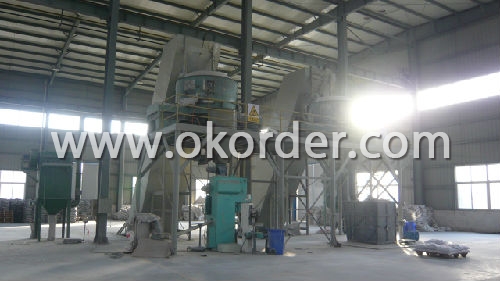

Feature of Alumina-Spinel Castable for Ladle
Long operating life
Easy execution and mending
Excellent corrosion and scouring resistance of iron steel
Application of Alumina-Spinel Castable for Ladle
ALRE alumina-spinel castable could be used widely for lining of ladles in steel and iron industry.
- Q: How are monolithic refractories recycled or disposed of at the end of their lifespan?
- Monolithic refractories at the end of their lifespan are typically recycled or disposed of through various methods. Recycling involves collecting the used refractory materials and processing them to remove any contaminants. The processed refractories can then be used as raw materials in the production of new refractory products. Disposal methods include landfilling in designated areas or utilizing waste-to-energy facilities to convert the refractories into energy. The choice between recycling and disposal depends on factors such as the condition of the refractories and the availability of recycling facilities in the area.
- Q: What are the challenges in recycling monolithic refractories?
- Recycling monolithic refractories presents several challenges that complicate the process compared to other materials. To begin with, the exceptional resistance of monolithic refractories to high temperatures and harsh conditions makes them difficult to break down and separate. Specialized techniques and equipment are required for this purpose. Furthermore, monolithic refractories often contain various additives and binders, such as clay, cement, and other organic compounds. These additional substances add complexity to the recycling process, as they may need to be removed or separated from the refractory material before effective recycling can take place. Moreover, monolithic refractories are prone to contamination during their service life, with metal oxides, slag, and impurities being common culprits. These contaminants can affect the quality and properties of the recycled refractory material, necessitating thorough cleaning and purification procedures. Additionally, the logistics involved in collecting and transporting monolithic refractories for recycling can be challenging. Given that refractories are typically used in large quantities in industrial settings, their removal and transportation can be costly and time-consuming. Furthermore, finding suitable recycling facilities equipped with the necessary expertise and equipment to handle monolithic refractories can be limited, particularly in certain regions. Lastly, economic factors contribute to the challenges of recycling monolithic refractories. The financial viability of recycling and processing these refractories may not always justify the cost compared to using new materials. Consequently, companies may be discouraged from investing in recycling programs, leading to lower demand for recycled refractory materials. In summary, the challenges associated with recycling monolithic refractories primarily arise from their durability, complex composition, contamination, logistics, and economic considerations. Nonetheless, with technological advancements and increased awareness of the environmental benefits of recycling, these challenges can be overcome, promoting the sustainable reuse of refractory materials.
- Q: How do monolithic refractories prevent thermal radiation in the iron and steel industry?
- Monolithic refractories play a vital role in the iron and steel industry by preventing thermal radiation. Thermal radiation is the transfer of heat energy through electromagnetic waves and poses a significant challenge due to the industry's high temperatures. Monolithic refractories are refractory materials that come in a single piece and are designed with exceptional thermal insulation properties. They have low thermal conductivity, meaning they do not conduct heat well. This quality allows them to act as a barrier against thermal radiation. In the iron and steel industry, monolithic refractories are commonly used as linings in furnaces, ladles, and other equipment exposed to extreme temperatures. These linings act as protective layers, preventing heat from escaping and reducing the emission of thermal radiation. Furthermore, monolithic refractories have high emissivity, which means they can absorb and re-emit thermal radiation effectively. This characteristic enables them to capture and contain heat within the equipment, minimizing the amount of radiation that escapes into the surroundings. By preventing thermal radiation, monolithic refractories help maintain the desired temperatures during the iron and steel production process. This is crucial for achieving efficient and controlled operations, as well as ensuring the quality of the final products. Moreover, the use of monolithic refractories in the iron and steel industry also contributes to energy savings. By reducing heat loss through thermal radiation, less energy is needed to maintain the desired temperatures, resulting in lower energy consumption and cost savings. In conclusion, monolithic refractories are indispensable for preventing thermal radiation in the iron and steel industry. Their excellent thermal insulation properties, low thermal conductivity, and high emissivity make them effective barriers against heat transfer through radiation. By minimizing heat loss and ensuring controlled temperatures, monolithic refractories contribute to efficient operations, high-quality products, and energy savings.
- Q: How are monolithic refractories used in the iron and steel industry?
- Monolithic refractories are used in the iron and steel industry for various applications such as lining furnaces, ladles, and tundishes, as well as repairing and maintaining the refractory linings. These refractories are often in the form of a dense, one-piece structure that can withstand high temperatures, thermal shocks, and chemical attacks from molten metals and slag. They provide insulation, corrosion resistance, and mechanical strength to the equipment and structures used in iron and steel production, ensuring efficient and reliable operations.
- Q: What are the considerations for repairing and patching monolithic refractories?
- When it comes to the repair and patching of monolithic refractories, there are several key factors that must be taken into consideration. First and foremost, it is crucial to thoroughly evaluate the extent and severity of the damage or deterioration. This assessment will help determine the most appropriate repair method and materials required. Minor cracks or small damages may only necessitate a simple patch or seal, whereas larger or more serious damage may require a complete replacement or a more extensive repair process. Secondly, the type of monolithic refractory material being utilized is a critical factor to consider. Different types of monolithic refractories possess varying properties and characteristics, such as thermal conductivity, chemical resistance, and mechanical strength. Therefore, it is vital to select a repair material that is compatible with the existing refractory material, ensuring proper bonding and optimal performance. Another factor to take into account is the operating conditions and environment in which the monolithic refractory is exposed. Variables such as temperature, pressure, chemical exposure, and abrasion can significantly impact the durability and longevity of the refractory material. Understanding these conditions will assist in selecting the appropriate repair materials and techniques that can withstand and perform well under these specific circumstances. Furthermore, it is imperative that the repair process is carried out by experienced personnel who possess knowledge about refractory materials and their installation. Improper repairs can lead to further damage or diminished performance, so it is essential to have skilled professionals who can execute the repair work correctly. Lastly, regular inspection and maintenance of the monolithic refractories are crucial in order to detect any potential damage or deterioration early on. Timely repairs and patching can prevent further deterioration and prolong the service life of the refractory material. In summary, the considerations for repairing and patching monolithic refractories involve evaluating the extent of damage, selecting compatible repair materials, understanding the operating conditions, employing skilled personnel, and conducting regular inspections and maintenance. By taking these factors into account, one can ensure effective repairs and the continued performance of monolithic refractories.
- Q: What are the common failure mechanisms of monolithic refractories?
- Common failure mechanisms of monolithic refractories include thermal spalling, chemical attack, erosion, and mechanical stress. Thermal spalling occurs when the refractory material is exposed to rapid temperature changes, leading to the cracking and breaking of the refractory lining. This can happen due to thermal shock, such as when a cold material is suddenly exposed to high temperatures, or when the refractory is subjected to cyclic heating and cooling. Chemical attack occurs when the refractory material comes into contact with aggressive chemicals or gases that can react with and degrade the refractory lining. This can lead to the formation of new compounds or the dissolution of the refractory material, weakening its structure and reducing its resistance to further chemical attack. Erosion is another common failure mechanism, especially in applications where the refractory lining is exposed to high-velocity gas or liquid flows. The abrasive action of the flowing medium can gradually wear away the refractory material, leading to thinning and eventual failure of the lining. Mechanical stress, such as thermal expansion or contraction mismatch, can also cause failure in monolithic refractories. When the refractory material is subjected to rapid temperature changes, differential expansion or contraction can occur, leading to the development of cracks and fractures in the lining. To mitigate these failure mechanisms, various techniques can be employed, such as proper material selection based on the specific operating conditions, careful design to minimize thermal gradients, use of protective coatings, and regular inspection and maintenance to identify and address any signs of failure or degradation.
- Q: How do monolithic refractories enhance the performance of ladle and tundish purging systems?
- Monolithic refractories enhance the performance of ladle and tundish purging systems by providing high thermal insulation, excellent erosion resistance, and increased durability. These refractories help maintain the desired temperature in the ladle and tundish, ensuring optimal conditions for purging operations. Additionally, their erosion resistance properties prevent excessive wear and tear, extending the lifespan of the purging systems. Overall, monolithic refractories play a crucial role in enhancing the efficiency and effectiveness of ladle and tundish purging systems.
- Q: What are the recommended curing times for monolithic refractories?
- The recommended curing times for monolithic refractories vary depending on the specific type and manufacturer's instructions. However, in general, it is recommended to allow monolithic refractories to cure for at least 24 to 48 hours before subjecting them to any heat or thermal stress. It is important to follow the specific curing guidelines provided by the manufacturer to ensure optimal performance and longevity of the refractory material.
- Q: How do monolithic refractories improve the efficiency of ladle and tundish lining systems?
- Monolithic refractories improve the efficiency of ladle and tundish lining systems by providing superior thermal insulation, excellent resistance to thermal shock, and higher mechanical strength compared to traditional brick or castable linings. This results in reduced heat loss, improved temperature control, and increased refractory life, ultimately leading to higher productivity and cost savings in steelmaking operations.
- Q: What are the key factors to consider when designing the lining system with monolithic refractories?
- When designing a lining system with monolithic refractories, there are several key factors that need to be considered in order to ensure optimal performance and longevity of the lining. These factors include: 1. Material selection: Choosing the right monolithic refractory material is crucial. Factors such as the operating temperature, chemical environment, and mechanical stress need to be taken into account. Different monolithic refractories have varying properties and performance characteristics, so selecting the most suitable material for the specific application is essential. 2. Thermal expansion: Monolithic refractories, like any other material, expand and contract with changes in temperature. It is important to consider the thermal expansion properties of the refractory material and how it will interact with the surrounding structure. Proper expansion joints or design features should be incorporated to accommodate thermal expansion and prevent cracking or spalling. 3. Installation technique: The method of installation plays a critical role in the performance of the lining system. It is important to follow the manufacturer's guidelines for mixing, placing, and curing the monolithic refractory material. Improper installation can lead to reduced lining integrity, decreased thermal conductivity, and compromised structural stability. 4. Bonding and anchoring: Ensuring a strong bond between the monolithic refractory and the substrate is essential for effective lining performance. Proper surface preparation, selection of suitable bonding agents, and appropriate anchoring techniques should be considered to enhance the adhesion and stability of the lining system. 5. Structural design: The structural design of the lining system should be carefully planned to withstand the mechanical stresses and operational conditions. Factors such as load-bearing capacity, thermal shock resistance, and thermal cycling should be taken into consideration during the design phase. Reinforcement materials, such as steel fibers or mesh, may be required to enhance the structural integrity and prevent cracking or spalling. 6. Maintenance and repair: Anticipating the need for maintenance and repair is crucial for the longevity of the lining system. Consideration should be given to access points, inspection ports, and repair techniques. Regular inspections and proactive maintenance can help identify and address any issues before they escalate and lead to major failures. By considering these key factors when designing the lining system with monolithic refractories, one can ensure a well-designed and effective lining that can withstand the harsh conditions and provide long-term performance.
1. Manufacturer Overview
| Location | Henan, China |
| Year Established | 2007 |
| Annual Output Value | Above US$ 200 Million |
| Main Markets | North America;Asia;Western Europe;Africa;Russia;Middle East |
| Company Certifications | ISO 9001:2008 |
2. Manufacturer Certificates
| a) Certification Name | |
| Range | |
| Reference | |
| Validity Period |
3. Manufacturer Capability
| a) Trade Capacity | |
| Nearest Port | Tianjin |
| Export Percentage | 20% - 30% |
| No.of Employees in Trade Department | 10-20 People |
| Language Spoken: | English; Chinese |
| b) Factory Information | |
| Factory Size: | Above 150,000 square meters |
| No. of Production Lines | Above 10 |
| Contract Manufacturing | Installation guide, OEM Service Offered |
| Product Price Range | High; Average |
Send your message to us
Alumina-Spinel Castable for Ladle
- Loading Port:
- China Main Port
- Payment Terms:
- TT or L/C
- Min Order Qty:
- 2 MT m.t.
- Supply Capability:
- 5000 Tons Per Month m.t./month
OKorder Service Pledge
OKorder Financial Service
Similar products
Hot products
Hot Searches
Related keywords














